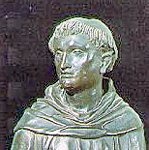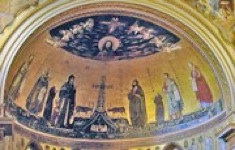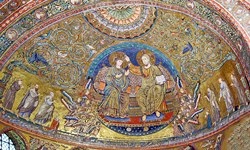


Detail of St Antony of Padua (1448) by Donatello
Basilica di Sant'Antonio, Padua
An entry in the Roman Martyrology under 13th June reads: “At Padua, St Anthony, a native of Portugal, priest of the Order of Friars Minor and confessor, illustrious for the sanctity of his life, his miracles, and his preaching. Pope Gregory IX placed him on the canon of the saints within a year after his death”.
St Antony was born in Lisbon in about 1195 and became an Augustinian Canon Regular, first in Lisbon and then at the monastery of Santa Cruz at Coimbra. During his novitiate at Coimbra, he received the thorough grounding in theology and biblical exegesis that was to sustain him for the rest of his life.
His transfer to the Franciscan Order was probably a matter of chance: he became acquainted with a small band of friars that had settled in the little chapel of St Antony of Egypt at Olivais, near his monastery of Santa Cruz, in 1217. He must have been impressed by the austerity of their lives, which offered a stark contrast to the lax lives led by many of his superiors at Santa Cruz. He was particularly impressed by the example of the Franciscan proto-martyrs, whose relics were brought from Morocco, the place of their martyrdom, to Santa Cruz in 1220. He therefore transferred to the Franciscan Order on condition that he too would be sent as a missionary to Morocco, where he hoped to die for Christ. (He had been christened Ferdinand, but he took the name of Antony in honour of the dedication of the friars' chapel at Olivais).
St Antony duly set out for Morocco but was forced to return due to ill health. His ship was driven by a storm to Sicily, and he made his way from there to Assisi to attend the so-called Chapter of Mats in 1221.
St Antony in Italy
The Chapter of Mats at the Portiuncula, outside Assisi was St Antony's first experience of the mainstream of his new Order, and it must have been a difficult one: St Francis, its charismatic founder, was severely incapacitated by ill-health, and the contentious matter of the formulation of the Franciscan Rule was the central topic at the meeting.
It was by no means clear what St Antony would do next. However, he was able to secure a place at the hermitage of Monte Paolo near Forli, where the friars, who were all lay brothers, needed a priest who could celebrate Mass for them. When he was asked to preach some 15 months later, his talent for preaching suddenly became apparent.
St Antony was first asked to use his talents by preaching against the heretics of Romagna. Then, in 1223, St Francis gave him permission to teach theology to the friars at Bologna. (This marked a change of direction for St Francis, who had railed against the studium at Bologna when he visited the city in 1221). In 1224, he was assigned to southern France, the centre of the mission against the Cathars. St Antony returned to Italy in 1227 to attend the General Chapter following St Francis' death and during this meeting he was elected Provincial Minister of Lombardy.
St Antony resigned at the General Chapter that was held in Assisi in 1230, just before leaving for Rome as part of the delegation that asked Pope Gregory IX for his elucidation of the Franciscan Rule. This elucidation in the bull Quo elongati consolidated the "conventual" character of the order. (Unlike St Francis, St Antony was a cleric, and he had joined the Order at a time when it was becoming clericalised. Thus, although he was a contemporary of St Francis, he belongs to the second generation of Franciscans, to the new learned and clerical element).
He then retired to Padua, where his preaching and teaching brought great renown to the city. The last few months of his life there were perhaps his most productive. During Lent 1231, his daily outdoor preaching led to a religious revival in the city, and the friars were overwhelmed by people streaming to their tiny church of Santa Maria Mater Domini to make confession.
It was during this busy period that St Antony also prepared a number of his sermons for publication as the Sermones Dominicales (i.e. for the Sundays of the liturgical year) and the Sermones Festivi (for the feasts of the saints). These sermons were published in a form that could be used to inspire the preaching of the friars. They illustrated St Antony's own brand of Franciscan theology, which was rooted in a profound love of Christ, reverence for and deep knowledge of the Gospels, adherence to poverty and to the joy of abandoning oneself totally to God. Perhaps surprisingly, the sermons make no mention of the recently canonised St Francis.
Exhausted by so much activity, Antony began a retreat just outside Padua but became ill. During his journey back to the city, he stopped to rest at a convent of the Poor Clares at Arcella, where he died. The nuns and local residents tried to keep his body but, despite an armed insurrection that lasted several days, the bishop and the civic authorities ensured that it was buried at Santa Maria Mater Domini.
Cult of St Antony
In the wake of the religious revival that St Antony had stimulated, there were numerous reports of miracles at his tomb. The Paduan authorities, with the support of the University of Padua, fanned this wave of popular devotion and formally promoted his canonisation. This was duly achieved only a year after his death. Pope Gregory IX conducted the service of canonisation in 1232 in the Duomo of Spoleto.
It seems likely that the first biography of St Antony, the so-called “Assidua”, was written at this time. Its author seems to have been a Franciscan friar who seems to have been a witness to the events surrounding St Antony's death, burial and canonisation. His account deals overwhelmingly with the last few months of St Antony's life and linked him indelibly with city. The model of holiness established in the Assidua is that of a preacher whose martyrdom was one of exhaustion associated with his apostolic zeal and devotion to the faithful. Interestingly, St Francis was mentioned only peripherally in the Assidua, although in the slightly later Divine Office of St Antony by Julian of Speyer, St Antony is praised as an, "emulator of his father Francis".
Work began in 1238 on the huge basilica of St Antony (popularly known as “il Santo”), which incorporated Santa Maria Mater Domini as its left transept. It was interrupted in 1237-56 when the fiercely anti-papal Ezzelino da Romana occupied the city. The city's liberation in 1256 and Ezzolino's death in 1259 were ascribed to the intercession of St Antony, and his cult was revived. Pope Alexander IV urged the Paduans to finance the completion of il Santo in honour of the saint who had protected them, and granted indulgences to those who did so.
In 1263, St Bonaventure presided over the translation of the relics of St Antony from the left transept to a site in front of the high altar in 1263. They were contained in a marble sarcophagus on a platform that was raised on pillars so that those seeking miraculous cures could lie underneath it. A flight of steps led up to the platform so that Mass could be celebrated using the sarcophagus as an altar. St Antony’s tongue, which was found to be incorrupt at this time and which symbolised his skill as a preacher, was enclosed in a separate reliquary.
At a meeting held in Padua in 1276, the Franciscans formally agreed that St Antony should be recognised as the most important Franciscan saint after St Francis. The “Benignitus”, a biography of St Antony by an unknown author that incorporated miracles reported since his canonisation, was probably commissioned at this time. The cult of St Antony as a prolific miracle worker derives from this account.


In ca. 1290, SS Francis and Antony appeared for the first time in a non-Franciscan church alongside SS Peter, Paul and John the Baptist, in a mosaic that Pope Nicholas IV commissioned from Jacopo Torriti for the apses of San Giovanni Laterano, Rome and Santa Maria Maggiore, Rome (illustrated above, to left and right respectively).
The relics of St Antony were translated to an unknown location in Sant’ Antonio in 1310, and to their current location, the Cappella dell' Arca del Santo in the left transept, in 1350. The sarcophagus was again mounted on a platform on marble columns, and a flight of steps leading up to it.
Stefano da Ferrara executed a cycle of frescos (ca. 1360)of scenes from the life and miracles of St Antony on the walls of the chapel. These subsequently deteriorated, and a bequest from Brother Francesco Sansone was used for a major programme of redecoration that began in 1499. The work involved a dozen artists and extended over a period of almost a century. Its most important element was a cycle of nine marble reliefs (1500-77) on the walls that depicted scenes from the life of St Antony and his posthumous miracles. The sarcophagus was now placed within a new altar, with its position marked by a green marble slab on the exterior that pilgrims could touch.
Cult in Spoleto

His cult within the city revolved around an image that was believed to be an authentic portrait of the saint: according to tradition, the people of Padua had presented it to Pope Gregory IX when he was in Spoleto for the canonisation. This image is recorded in a chapel in SS Simone e Giuda that was dedicated to the saint from the 15th century. When the church was suppressed in 1863, the heavily repainted image passed into private ownership.
In 1602, St Antony was designated as one of the patron saints of Spoleto at the behest of the friars of SS Simone e Giuda. The cult was reinforced in 1698 when the Princess Olimpia Giustiani Barberini (the wife of Maffeo Barberini, Prince of Palestrina and son of Taddeo, the nephew of Pope Urban VIII) gave a relic of the cranium of St Antony in a precious reliquary to the friars and it was translated with great ceremony to SS Simone e Giuda. The friars took the reliquary with them when they moved to Sant' Ansano in 1896, and they duly changed the dedication of their new church to SS Ansano e Antonio. Unfortunately, the venerated relic of St Antony was proved to be false in 1981, when the body of the saint at Padua was investigated and found to be complete.





